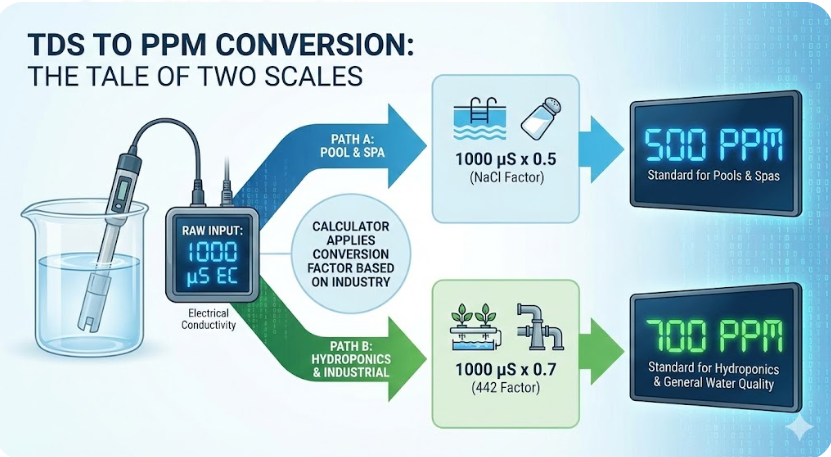TDS to PPM Calculator
Convert Total Dissolved Solids (TDS) between mg/L and PPM, or estimate using Electrical Conductivity (EC).
Water TDS to PPM Calculator – Check Your Water Quality Fast
Easily convert TDS readings to PPM to assess drinking water quality and filter performance. Ideal for RO systems, tap water testing, and water purification.
Are you a gardener, aquarist, or water quality professional wondering about your water’s purity? Our TDS to PPM Calculator is the perfect tool for you. It helps you quickly convert your water’s total dissolved solids (TDS) value into parts per million (PPM), giving you a clear picture of its quality for everything from hydroponics to drinking.
What Is TDS and How Does It Relate to PPM?
TDS stands for Total Dissolved Solids, and it measures the amount of organic and inorganic substances (like minerals, salts, and metals) dissolved in water. The most common unit for measuring TDS is parts per million (PPM), which means that a reading of 500 PPM indicates there are 500 milligrams of dissolved particles in every liter of water.
This calculator simplifies the process, saving you from manual calculations. Whether you’re a hydroponic grower needing to maintain ideal nutrient levels or a homeowner testing your tap water, understanding these values is crucial.
How to Use Our Calculator
Our TDS to PPM calculator is designed to be straightforward and fast.
- Enter your TDS value from your meter reading.
- Select the appropriate conversion factor for your meter. Common factors are 0.5 (for NaCl) or 0.7 (for 442). Your meter’s manual will specify which factor it uses.
- Click “Calculate” to instantly get your PPM result.
This tool is especially useful for answering questions like:
- “How do I convert my TDS reading to PPM?”
- “What’s the difference between TDS and PPM in water testing?”
- “How do I know if my water is safe for my plants or fish?”
Developed by PPMCalculator.com, this tool supports laboratory, industrial, and research applications with precise calculation methods and dependable outputs.

What Do the Results Mean?
After using the calculator, the PPM value helps you make informed decisions. For instance:
- 150-250 PPM: Ideal for hydroponic plant growth, as this range suggests the perfect concentration of nutrients.
- 300-500 PPM: Typically considered safe for drinking water by many health organizations.
- 700+ PPM: May indicate a high concentration of impurities, which could be harmful to sensitive plants or impact the taste of drinking water.
Understanding these numbers allows you to adjust nutrient solutions, use a water filter, or take other actions to ensure optimal water quality. For precise measurements and reliable results, we recommend using a high-quality TDS meter.
Here are more related pages and posts from your site that complement the TDS to PPM Calculator and provide valuable insights into water quality measurements, conversions, and related calculations:
- How to Calculate PPM Step-by-Step — A detailed guide on calculating parts per million accurately.
- PPM Conversion Table — Handy reference for converting between various concentration units.
- PPM vs TDS vs EC — Explains the differences and relationships between PPM, Total Dissolved Solids, and Electrical Conductivity.
- Online Calculator: Electrical Conductivity and Total Dissolved Solids — Tools and explanations for converting EC to TDS and vice versa.
- TDS Calculator | Convert EC to TDS (ppm, mg/L) — Calculator for converting electrical conductivity readings to TDS values.
- PPM Best Practices for Lab Work — Tips to ensure accurate and reliable PPM measurements in laboratory settings.
- Troubleshooting PPM Calculator Results — Common issues and fixes when working with PPM calculations.
- Safe PPM Levels Drinking Water — Guidelines on safe concentration levels for drinking water.
- PPM Formula Variations — Different formulas and approaches to calculating PPM depending on context.
- PPM Accuracy Calculator — Tool to assess the accuracy of your PPM measurements.
